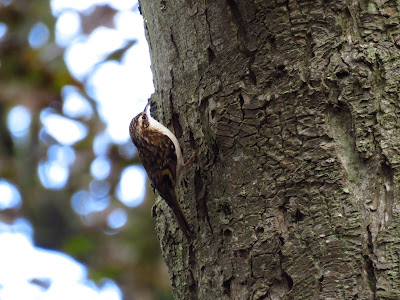I feel a strong pull to head to the coast to witness the wonder of migration. A cold breeze and showers wasn't ideal for a walk, but I decided on start at Kilnsea Wetlands, making a stop there and then heading towards Beacon Lane and the 'Spurn triangle'. Kilnsea Wetlands never disappoints, there were lots of wildfowl and gulls about, including plenty of Mediterranean Gulls, Pintail, some Dunlin, Ruff and Black-tailed Godwit. I didn't find the Garganey. It required a lot of patience, and a telescope to check trough the hundreds of Teal.
A large flock of Tree Sparrows and some Redwing were the best of Beacon Lane.
I checked my phone. There was a tweet at #spurnbirds that a Great White Egret had just flown over the acoustic mirror. I started walking pretty fast towards Canal Scrape. Although I have seen the species before at The Netherlands, it has been my UK bogey bird for years. A birder I met on the way told me it had dropped at Canal Scrape, and a moment later I saw it fly over the highland cattle grazing the field next to canal scrape. It dropped in an inaccessible area.
No matter, I'd seen it and ticked it, right? I went to Canal Scrape anyway and entertained myself watching the Moorhens and Mute Swans in residence. Everybody left. After a while, I decided it wasn't going to be my day and left the hide. But, just then, through the chicken wire by the hide as I walked away, I saw the Great White Egret! I retraced my steps really quietly, closed the hide door slowly, and peeked over the window. There it was! barely 3 m away from me. At this point I had the hide, and the wonderful Great White Egret to myself!
The Great White Egret was very entertained fishing sticklebacks. It often walked with its extremely long neck outstretched forward.

At some point it coils its neck and sways it side to side, cat-like, before the deadly dart of its bill picked a tiny fish with amazing precision.

Then repeat. I didn't see it fail. I noticed how it wiggled its feet, in a more subtle way than the Little Egret does, disturbing the sediments and probably small aquatic invertebrates that attract little fish to death-by-egret. This is a clip of the behaviour.
Great White Egrets are a virtually cosmopolitan species, but they are still regarded as scarce visitors in the UK. They were a rarity in the UK not long ago. Now several pairs have bred, the first pairs on the Somerset Levels in 2012, then at Holkham in 2017, and they are becoming more abundant and widespread.
After a short walk to Numpties I returned to Canal Scrape for lunch. The GWE still fishing, it gave great photographic opportunities.






















































